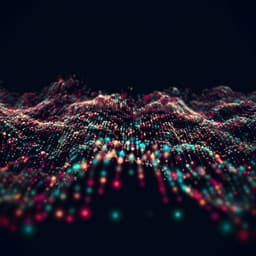
Environmental Studies and Forestry
Food demand displaced by global refugee migration influences water use in already water stressed countries
L. Bertassello, M. F. Müller, et al.
Millions of refugees have relocated to water-scarce countries, impacting local water security. This research by Leonardo Bertassello, Marc F. Müller, Adam Wiechman, Gopal Penny, Marta Tuninetti, and Michèle C. Müller-Itten reveals that refugee displacements have significantly increased water stress, suggesting that minor adjustments in food supply and resettlement procedures could alleviate pressures on these vulnerable regions.
~3 min • Beginner • English
Introduction
The study investigates how international refugee migration affects water stress in host countries by displacing food demand and the water required to produce that food. Motivated by rising global forced displacement—especially from arid and semi-arid regions such as Syria, Iraq, Palestine, and Afghanistan—and by concerns over water scarcity’s interaction with conflict, the paper reframes water as a consequence of conflict through migration-driven demand shifts rather than solely as a conflict driver. It builds on the concept of virtual water and per capita water footprints to quantify how refugees’ food consumption patterns and supply chains alter the distribution of blue water use (irrigation-dependent) and, hence, national water stress. The research aims to measure the magnitude and spatial distribution of refugee-related water demand and assess policy levers—trade and resettlement—that could alleviate stress in already water-vulnerable host countries.
Literature Review
The paper situates itself within two main literatures: (i) water resources and armed conflict, where most prior work has focused on water scarcity as a driver of conflict and on warfare’s impacts on local water quality/quantity and infrastructure; and (ii) virtual water trade and water footprints, which track water embedded in agricultural goods across borders. Prior research shows economic migrants can induce virtual water flows via export of homegrown goods to diaspora markets, whereas refugees often move to nearby countries with similar climates and disrupted domestic production, shifting demand to host countries. The authors reference studies on Syria’s conflict impacts on regional hydrology, the global virtual water trade network, SDG 6.4.2 water stress metrics, and evidence that refugees often retain traditional diets, influencing consumption profiles. They also note emerging work on environmental changes near IDP camps and emphasize the relative neglect of migration-driven virtual water dynamics compared with commodity trade.
Methodology
The analysis integrates global refugee displacement data with food virtual water footprints and national water accounts over 2005–2016. Key elements:
- Data sources: UNHCR/UNRWA refugee stocks by origin–destination–year; CWASI database (1961–2016) for virtual water footprints (blue and green) of 370 primary and processed food products, including international trade flows and production-side water intensities; FAO AQUASTAT for total freshwater withdrawals (TFWW), total renewable water resources (TRWR), environmental flow requirements (EFR), irrigation water requirements (IWR), irrigation water withdrawals (IWW), and populations.
- Definitions: Blue water is irrigation-dependent surface/groundwater and reclaimed wastewater; green water is soil moisture from rainfall. The study focuses on blue water implications for water stress. Gray water (pollutant assimilation) is excluded. Water demand refers to water embedded in food consumed; water footprint refers to water withdrawn in a country to produce consumed food (can be exported via trade).
- Per capita footprints: For each destination country d and year y, the per capita water footprint of consumption by food type k is computed (c_dky). Trade allocation factors x_dpky assign the share of embedded water ultimately sourced from producer country p.
- Long-run (LR) vs short-run (SR): LR assumes refugees adopt host-country dietary habits and supply systems; SR assumes refugees maintain origin-country dietary habits but consume via the host’s supply system. LR per capita water in producer country p for consumption in d follows an accounting akin to Equation (1) in the text. SR combines origin dietary quantities (from FAO Food Balance Sheets) with host-country water intensities W_dky.
- Refugee matrices: For each origin o, destination d, year y, R^od gives refugee counts. The blue water footprint in country p from refugees displaced o→d is ABWF_p,SR/LR^od = R^od ω_p,SR/LR^od (Eq. 3). Aggregations yield displaced blue water demand by origin ΔBW^D_o and destination ΔBW^D_d, and global refugee-related blue water footprint by producer country ΔBW^F_p (Eqs. 4–6).
- Water stress impacts: Water stress S^p_y = TFWW^p_y / (TRWR^p_y − EFR^p_y) (Eq. 7). Change due to refugees ΔS^p_y,SR/LR = ΔBW^F_p,SR/LR / (TRWR^p_y − EFR^p_y), adjusted by irrigation efficiency e = IWR/IWW to reconcile net consumption and gross withdrawals (Eq. 8). Missing EFR set to 0 for 10 arid countries; missing IWW replaced by agricultural withdrawals.
- Scope and exclusions: Countries hosting/supplying <1,000 refugees throughout 2005–2016 were excluded. 167 countries remained; 39 lacked sufficient water data (Table S1). Refugees moving into those 39 were excluded (~5% of global refugees). Internally displaced persons (IDPs) are excluded due to lack of subnational water data.
- Resettlement trade-off model: For 2020 UNHCR projected resettlement needs (~1.44M refugees), the study estimates country-specific marginal water stress effect per refugee ΔS_d,SR using 2016 data (Eq. 9). Refugee “hardship” is modeled as exponentially distributed waiting time with rate λ_d inferred from the fraction selected for resettlement in each country (λ_d = ln R_d − ln Q_d^UN, Eq. 11). Feasible plans resettle no more people than current UNHCR plan. Pareto-optimal plans maximize a weighted combination of aggregate hardship relief Δτ(Q) (Eq. 12) and host-country water stress relief ΔS(Q) = Σ_d Q_d ΔS_d,SR (Eq. 13).
- Food import relief: For 2016, by host d and product k, compute total refugee consumption C′_dk (assuming origin diets), the locally produced fraction X′_ddk contributing to stress ΔS′_dk, and the additional blue water imports Δl_dk required to avert that stress while maintaining current import shares across exporter countries. This yields non-linear relationships between increased blue water import and water stress relief by commodity.
Key Findings
- Global magnitude: The long-run water footprint of refugee displacement reached ~31 km³/year in 2016, a ~75% increase since 2005. This is ~10× smaller than economic migrants (~400 km³/year) and ~100× smaller than global food trade (~2,300 km³/year).
- Per capita context (ca. 2010): Refugees’ average per capita water footprint: home 1,150 m³/person/year; destination 1,438 m³/person/year. Economic migrants: 1,572 and 2,064 m³/person/year, respectively. Refugee flows are often regional, linking countries with relatively lower per capita footprints.
- Most destinations: Refugees’ blue water footprint (BWF) is <1% of total renewable water resources (after EFR) in most countries; thus, impacts on national water stress are minimal for the majority.
- Europe: EU food systems are predominantly rain-fed (~6% blue water in per capita food footprints). ~1.1M Syrian/Afghan refugees by 2016 displaced only ~0.083 km³/year of blue water demand to the EU in the long run, yielding negligible changes in water stress.
- Iran, Pakistan, Turkey: Despite large refugee inflows, impacts on national water stress are small due to scale and trade structures. Estimated Δ water stress (percentage points) from Table 2:
• Iran: SR 0.6; LR 1.0; ΔBWD 406–740 MCM/y; refugees ~1.0M
• Pakistan: SR 0.6; LR 0.7; ΔBWD 683–806 MCM/y; refugees ~1.9M
• Turkey: SR 0.3; LR 0.7; ΔBWD 282–651 MCM/y; refugees ~2.8M
• EU: SR 0.0; LR 0.0; ΔBWD 79–83 MCM/y; refugees ~0.8M
- Lebanon and Jordan: Large per-capita refugee presence and high pre-existing stress lead to sizeable impacts.
• Lebanon: Water stress rose from 35% to 59% (2005–2015). Short-run refugee BWF accounts for ~12.4 percentage points of this increase (about half). Long-run effect ~7.9 percentage points.
• Jordan: Refugee food demand contributed an estimated 47–75 percentage points to overall water stress (LR–SR). For registered Syrian refugees only and accounting for supply-side offset, net increase is ~13.5–24.2 percentage points (JOR*).
- Jordan supply–demand case: For registered Syrian refugees, SR blue water demand increased by ~109 MCM (2015) and ~217 MCM (2016). About 40% was met by imports in 2015, leaving ≥65 MCM sourced domestically. Yarmouk River flow into Jordan increased by ~50 MCM/year (2011–2015 vs. pre-2011); ~55% attributed to abandoned Syrian irrigation. Of that refugee-attributed increase, ~80% (~18 MCM) was usable by Jordanian agriculture in 2015, offsetting only ~39% of the refugee-induced domestic blue water demand that year.
- Resettlement effects: Resettling the 1.44M refugees identified by UNHCR (2020) to water-abundant countries would reduce host-country blue water demand by ~99.7 MCM/year, translating to ≤2 percentage points relief in water stress for host countries on average. Reallocating ~15% of resettlement slots from Turkey/Uganda/Ethiopia/Iran to Jordan/Lebanon nearly doubles average water stress relief at the cost of ~5% lower average hardship relief (Pareto trade-off).
- Trade-based relief: Fully offsetting the short-run refugee-induced water stress via imports would require increases in blue water imports of ~14% (Jordan) and ~24% (Lebanon). Targeted increases are highly effective: in Jordan, a ~2% increase in blue water imports focused on wheat, poultry, tomatoes, and olives could alleviate nearly 30 percentage points of water stress—more than relocating all 0.7M UNHCR-registered refugees in Jordan.
- Distributional insight: A small set of already water-stressed host countries carries a disproportionate share of the global refugee BWF; many rely heavily on local water for food production and have more water-intensive diets, limiting relief from existing trade patterns.
Discussion
The findings demonstrate that while the global refugee-related water footprint is modest compared to overall trade and migration-related virtual water flows, its impacts are highly uneven, concentrating in a few water-scarce host countries—most notably Jordan and Lebanon—where additional blue water demand can dramatically exacerbate already high water stress. This addresses the research question by quantifying the magnitude and local expression of migration-induced virtual water shifts and linking them to SDG 6.4.2 metrics. The study expands the virtual water concept from goods to people, showing that human displacement can transmit hydrological stresses across borders through food systems. Policy-relevant insights include: (i) for most destinations, refugee-related food water demand is not a significant driver of water stress, countering narratives that refugees broadly overburden host resources; (ii) in critical hotspots, targeted interventions—especially increased imports of specific water-intensive foods from water-abundant exporters—can yield large water stress relief at relatively small trade adjustments; and (iii) modest adjustments to resettlement allocations can improve aggregate water stress relief with limited trade-offs in hardship alleviation, though ethical and political considerations are paramount. The work underscores that water should not singularly guide migration or trade policy but should inform integrated strategies addressing water justice, inequality, and resilience of food trade networks under conflict and climate risks.
Conclusion
This study quantifies the virtual water associated with refugee displacement globally and links it to host-country water stress, extending the virtual water framework from supply chains to migration. The water footprint of refugee displacement rose ~75% (2005–2016) to ~31 km³/year, with limited impacts in most destinations but substantial effects in already water-stressed hosts such as Jordan and Lebanon. The analysis highlights two actionable levers: (i) targeted increases in imports of water-intensive foods from water-abundant countries can disproportionately reduce short-run refugee-induced water stress; and (ii) incremental changes to resettlement allocations can enhance water stress relief in the most burdened hosts without greatly diminishing hardship relief. Policy relevance lies in identifying emerging water-security hotspots and informing operational models for integrated water–food–migration planning. Future research should address subnational dynamics and IDPs, incorporate domestic (non-food) water use, account for coping strategies affecting consumption, refine trade elasticity and supply-side responses, and evaluate climate–conflict interactions and the resilience of international food supply chains.
Limitations
Key limitations include: exclusion of gray water; reliance on national-scale data, excluding IDPs and countries with missing water data (about 5% of refugees into those destinations omitted); assumption that recent refugees preserve origin-country diets in the short run and adopt host diets in the long run; limited accounting for coping strategies under food insecurity (potential overestimation of BWF); treatment of in-kind food aid as negligible for country-average virtual water intensity (could bias SR estimates where aid is substantial); assumption that per capita refugee water intensities match locals’ supply-side water intensities; well-mixed trade and constant exporter shares in import-relief scenarios; linear interpolation of AQUASTAT variables; setting EFR = 0 where unavailable; using irrigation efficiency (IWR/IWW) to bridge net/gross water metrics; modeling resettlement hardship with an exponential waiting-time proxy and assuming resettled refugees move to low-stress, high-income destinations; and not fully capturing domestic (non-food) water uses in main BWF calculations, which can be significant in hotspots.
Related Publications
Explore these studies to deepen your understanding of the subject.







